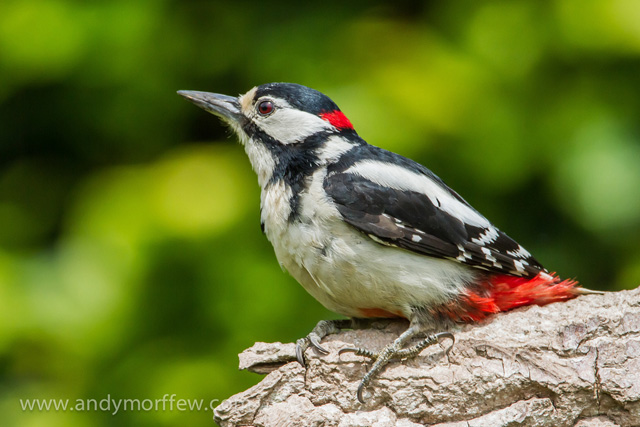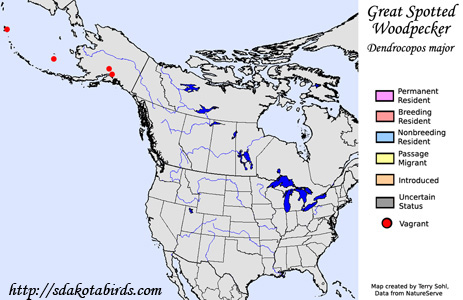| Length: 9 inches | Wingspan: 14-16 inches | Seasonality: Non-resident in South Dakota |
| ID Keys: Red under tail, black upperparts with white shoulder patch, white forehead, cheeks, and throat, white breast and belly | ||
 The
Great Spotted Woodpecker is a woodpecker of the Old World, with an immense
range that spans from Great Britain in the west, all the way across Eurasia
to northern Japan, and as far south as northern Africa. In North
America, they are known from a handful of sightings in Alaska, including
from Attu Island on the outermost edge of the Aleutian Islands.
The
Great Spotted Woodpecker is a woodpecker of the Old World, with an immense
range that spans from Great Britain in the west, all the way across Eurasia
to northern Japan, and as far south as northern Africa. In North
America, they are known from a handful of sightings in Alaska, including
from Attu Island on the outermost edge of the Aleutian Islands.
Habitat: Found in forested habitats, usually in deciduous forests, but also utilizing conifer forests in some areas. Has adapted well to a human presence, and can be found in parks, gardens, and other vegetated urban areas.
Diet: Feeds on insects, feeding heavily on ants when available. They will also take nuts, fruits, and berries, as well as occasionally taking other items such as eggs or young nestlings. Diet often varies by season, with more insects in the summer months, and more vegetative material in the winter.
Behavior: Often forages by flying to the trunk of a tree and working its way up, searching for insects. Has also increasingly learned to obtain food from feeders.
Nesting: The nest of a Great Spotted Woodpecker is a cavity in a tree, excavated by both the male and female. The female lays between 4 and 7 eggs, with both parents helping to incubate the eggs, and feed the nestlings after they hatch.
Song: The drumming of a Great Spotted Woodpecker is 8 to 12 taps, tapering off at the end. The call note is a stout tshik sound.
Migration: Considered a permanent resident throughout its range.
Interactive eBird map: Click here to access an interactive eBird map of Great Spotted Woodpecker sightings
Similar Species: Distinct from other woodpeckers that have been seen in North America.
Feeders: Will attend feeders for suet, nuts, and fruits.
Conservation Status: Populations of Great Spotted Woodpecker are large, spread over a very wide geographic region, and may be increasing. The IUCN lists the Great Spotted Woodpecker as a species of "Least Concern".
Further Information: 1) Great Spotted Woodpecker at Attu Island, Alaska
2) Royal Society for the Protection of Birds - Great Spotted Woodpecker
3) British Garden Birds - Great Spotted Woodpecker
Photo Information: Photo taken by Andy Morffew - June 25th, 2012 - Itchen Abbas, Hampshire, England - Photo licensed under Creative Commons Attribution NoDerivs 2.0 Generic License
| Click below for a higher-resolution map |
 |
| South Dakota Status: Non-resident in South Dakota |
Additional Great Spotted Woodpecker Photos (coming soon!!)
